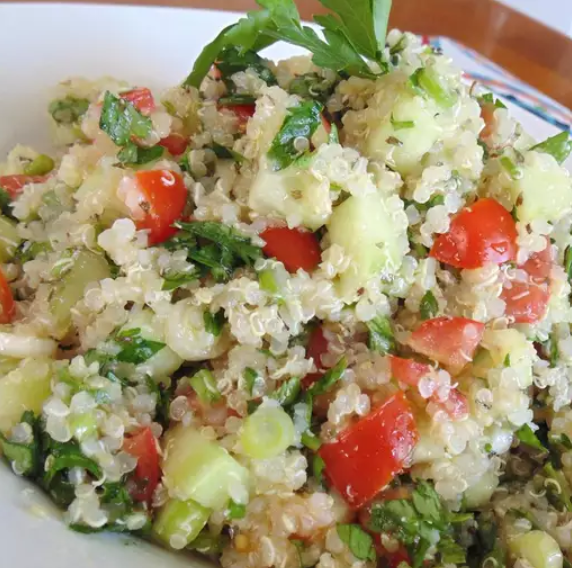
Introduction: Tabbouleh salad is a vibrant and refreshing dish originating from the Middle East, particularly Lebanon. Known for its fresh flavors and simple preparation, Tabbouleh has gained popularity worldwide for its health benefits and delicious taste. In this variation of the classic recipe, we’ll add the crispness of cucumber and the juiciness of tomato to enhance the already delightful combination of parsley, mint, bulgur, and lemon. Not only is this Tabbouleh salad bursting with flavor, but it’s also packed with nutrients, making it a perfect addition to any meal or a standalone dish. Let’s dive into the ingredients and instructions to create this mouthwatering salad.
Ingredients:
- 1 cup bulgur wheat
- 2 cups boiling water
- 2 large tomatoes, diced
- 1 English cucumber, diced
- 3 cups fresh parsley, finely chopped
- 1 cup fresh mint leaves, finely chopped
- 4 green onions, thinly sliced
- 1/4 cup extra-virgin olive oil
- 1/4 cup fresh lemon juice
- Salt and pepper to taste
Instructions:
- Prepare Bulgur Wheat: Place the bulgur wheat in a large bowl. Pour the boiling water over it, cover, and let it sit for about 30 minutes, or until the bulgur is tender and has absorbed all the water. Fluff with a fork.
- Prep Vegetables: While the bulgur is soaking, prepare the vegetables. Dice the tomatoes and cucumber into small, bite-sized pieces. Finely chop the fresh parsley and mint leaves. Thinly slice the green onions.
- Combine Ingredients: In a large mixing bowl, combine the soaked bulgur with the diced tomatoes, cucumber, chopped parsley, mint leaves, and sliced green onions.
- Dress the Salad: Drizzle the extra-virgin olive oil and fresh lemon juice over the salad. Season with salt and pepper according to your taste preferences.
- Toss and Chill: Gently toss all the ingredients together until well combined and evenly coated with the dressing. For best results, cover the salad and refrigerate for at least 30 minutes to allow the flavors to meld together.
- Serve: Once chilled, give the salad a final toss and transfer it to a serving dish. Garnish with additional parsley or mint leaves if desired. Serve Tabbouleh salad with cucumber and tomato as a refreshing side dish or as a light and healthy main course.
Serving Tips:
- Garnish Creatively: Before serving, consider garnishing your Tabbouleh salad with a sprinkle of sumac or toasted pine nuts for added flavor and texture.
- Pairing Suggestions: Serve Tabbouleh salad alongside grilled meats like chicken or lamb for a complete and satisfying meal. It also pairs well with falafel, hummus, or grilled vegetables for a vegetarian-friendly option.
- Presentation Matters: Present your Tabbouleh salad in a vibrant serving bowl or on a decorative platter to enhance its visual appeal and make it even more inviting to your guests.
- Fresh Lemon Wedges: Serve lemon wedges on the side to allow your guests to add an extra squeeze of lemon juice to their Tabbouleh salad, enhancing its brightness and freshness.
- Serve Chilled: For the most refreshing experience, serve your Tabbouleh salad chilled. Consider placing the serving bowl on a bed of ice to keep it cool during outdoor gatherings or hot summer days.
Storage Tips:
- Refrigerate Promptly: After preparing your Tabbouleh salad, refrigerate any leftovers promptly in an airtight container to maintain freshness and prevent the ingredients from wilting.
- Consume Within 2 Days: While Tabbouleh salad can be stored in the refrigerator for up to 2 days, it’s best enjoyed within the first day or two to ensure optimal flavor and texture.
- Avoid Freezing: Due to the delicate nature of the fresh herbs and vegetables, it’s not recommended to freeze Tabbouleh salad as it may result in a watery and mushy texture upon thawing.
- Refresh Before Serving: If your Tabbouleh salad has been refrigerated for a day or two, give it a quick toss before serving to redistribute the dressing and revive the flavors.
- Batch Preparation: To save time, you can prepare the ingredients for Tabbouleh salad in advance and assemble the salad just before serving. Keep the chopped vegetables and cooked bulgur wheat stored separately in the refrigerator until you’re ready to combine them. This way, you can enjoy freshly made Tabbouleh salad whenever you desire without compromising on quality.
Variations:
- Quinoa Tabbouleh: For a gluten-free alternative, substitute bulgur wheat with cooked quinoa. Quinoa adds a nutty flavor and a protein boost to the salad while still maintaining its light and refreshing qualities.
- Fruity Twist: Add a sweet and tangy dimension to your Tabbouleh salad by incorporating diced fresh fruits such as pomegranate seeds, diced apples, or ripe mangoes. The addition of fruits complements the savory elements of the salad and provides a burst of natural sweetness.
- Protein Powerhouse: Boost the protein content of your Tabbouleh salad by adding cooked chickpeas, grilled chicken, or crumbled feta cheese. These protein-packed additions make the salad more substantial and satisfying, perfect for a filling lunch or light dinner option.
- Spice it Up: Give your Tabbouleh salad a spicy kick by adding diced jalapeños, chopped chili peppers, or a pinch of crushed red pepper flakes. The heat from the spices adds depth and complexity to the flavors, making the salad more adventurous and exciting.
- Herb Variations: Experiment with different herbs to create unique flavor profiles. Replace or mix parsley with cilantro, dill, or basil for a refreshing twist. Each herb brings its own distinctive aroma and taste, giving your Tabbouleh salad a delightful herbaceous flavor.
- Grain Substitutions: Explore alternative grains such as couscous, farro, or bulgur wheat for a different texture and taste experience. Each grain offers its own unique characteristics, allowing you to customize the salad to your preference or dietary requirements.
- Nutty Crunch: Incorporate toasted nuts or seeds such as pine nuts, almonds, or sunflower seeds for added crunch and nuttiness. Toasting the nuts enhances their flavor and provides a satisfying texture contrast to the softness of the vegetables and grains.
- Asian Fusion: Give your Tabbouleh salad an Asian-inspired twist by replacing lemon juice with rice vinegar and soy sauce. Add ingredients like edamame, shredded carrots, and sliced radishes for an Asian-inspired crunch and flavor profile.
- Mediterranean Medley: Combine Tabbouleh salad with other Mediterranean ingredients such as diced bell peppers, kalamata olives, and crumbled feta cheese. The combination of flavors creates a vibrant and colorful salad with a Mediterranean flair.
- Avocado Addition: For a creamy and indulgent twist, add diced avocado to your Tabbouleh salad. Avocado adds richness and creaminess to the salad while providing healthy fats and nutrients. Just toss gently to avoid mashing the avocado pieces.
FAQs (Frequently Asked Questions):
- Is Tabbouleh salad gluten-free? Traditional Tabbouleh salad is made with bulgur wheat, which contains gluten. However, you can easily make it gluten-free by substituting bulgur wheat with quinoa or another gluten-free grain.
- Can I make Tabbouleh salad ahead of time? Yes, Tabbouleh salad can be made ahead of time. However, it’s best to add the dressing just before serving to prevent the salad from becoming soggy. You can prepare the ingredients in advance and assemble the salad shortly before serving for optimal freshness.
- How long does Tabbouleh salad last in the refrigerator? Tabbouleh salad can be stored in an airtight container in the refrigerator for up to 2 days. However, for the best flavor and texture, it’s recommended to consume it within the first day or two.
- Can I freeze Tabbouleh salad? Freezing Tabbouleh salad is not recommended as it may result in a watery and mushy texture upon thawing. The delicate fresh herbs and vegetables are best enjoyed fresh for the best taste and quality.
- Is Tabbouleh salad vegan? Tabbouleh salad is naturally vegan as it consists of fresh herbs, vegetables, and grains, dressed with olive oil and lemon juice. It’s a perfect option for vegans and vegetarians looking for a light and nutritious meal.
- Can I customize Tabbouleh salad to my taste preferences? Yes, Tabbouleh salad is highly customizable. You can adjust the ingredients, herbs, and seasonings according to your taste preferences. Feel free to add or omit ingredients to create a Tabbouleh salad that suits your palate.
- What can I serve with Tabbouleh salad? Tabbouleh salad pairs well with a variety of dishes such as grilled meats, falafel, hummus, grilled vegetables, or as a side dish to Middle Eastern-inspired meals. It also makes a delicious topping for sandwiches or wraps.
- Is Tabbouleh salad healthy? Yes, Tabbouleh salad is healthy as it’s made with fresh and nutritious ingredients including herbs, vegetables, and whole grains. It’s low in calories, high in fiber, and packed with vitamins and minerals, making it a nutritious addition to any diet.
Conclusion:
In conclusion, Tabbouleh salad with cucumber and tomato offers a delightful fusion of flavors and textures that captivates the palate with its freshness and vibrancy. Originating from the Middle East, this salad has become a beloved dish worldwide for its simplicity, versatility, and health benefits.
By combining the crispness of cucumber, the juiciness of tomato, and the aromatic herbs with nutty bulgur wheat, Tabbouleh salad provides a satisfying and nutritious meal or side dish. Whether served as part of a Mediterranean feast or enjoyed on its own, this salad never fails to impress with its vibrant colors and refreshing taste.
With its gluten-free and vegan-friendly options, customizable ingredients, and make-ahead convenience, Tabbouleh salad caters to a wide range of dietary preferences and lifestyles. Plus, its ability to be paired with various dishes makes it a versatile addition to any menu.
